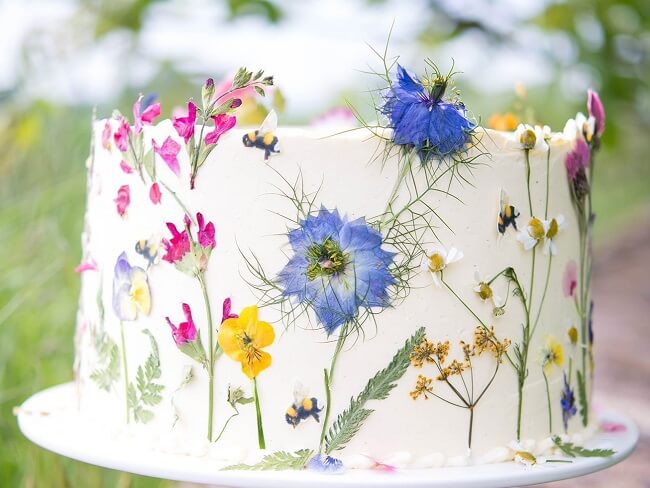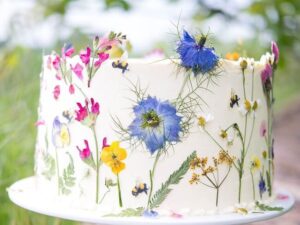Stunning Flowers For Cake Decorating: The Complete Handbook To Edible Floral Designs

Flowers For Cake Decorating
Key Takeaways:
- Understanding the difference between edible and non-edible flowers is essential for safe cake decorating.
- Historically, flowers have been used in culinary arts for both decoration and flavor enhancement.
- Top edible flowers include nasturtiums, pansies, roses, violets, hibiscus, lavender, calendula, chive blossoms, sunflower petals, and orchids.
- Pair flower flavors with your cake base; for example, lavender with chocolate or hibiscus with citrus cakes.
- Fresh flowers offer vibrancy but require careful sourcing; dried flowers provide longer-lasting decoration with concentrated flavors.
- Innovative decorating techniques include using sugar flowers, flower-infused syrups, gelatin encapsulation, and floral cake shifts.
- Harvest flowers in the morning from organic sources, handling them gently to maintain quality.
- Store fresh flowers upright in water and consider drying or freezing methods for preservation.
Embracing Nature’s Palette: The Art of Edible Flowers
Understanding Edible vs. Non-Edible: What You Need to Know
As the culinary world evolves, the incorporation of edible flowers into cake decorating has surged in popularity. To effectively harness the aesthetic potential of these blooms, one must first understand the critical distinction between edible and non-edible flowers.
Edible flowers are those that are safe for human consumption, adding not only visual appeal but also unique flavors and aromas to dishes. Common edible varieties include nasturtiums, pansies, orchids, and violets, all of which can be employed in cake decoration and food styling.
Conversely, many flowers may look beautiful but can be toxic when ingested. For instance, lilies are often stunning but should be avoided in any culinary application due to their detrimental effects on health. It is paramount that cake decorators educate themselves on which flowers can complement their cakes without posing health risks. Utilizing reliable resources, such as culinary herb books and databases, can help ensure that the flowers selected will enhance the cake’s aesthetic without compromising safety.
The History of Edible Flowers in Culinary Arts
The use of flowers in food dates back centuries, with ancient civilizations utilizing them both for flavor enhancement and as decorative elements in feasts and ceremonies. The Greeks and Romans would adorn elaborate dishes with blossoms, believing them to imbue a dish with beauty and harmony.
During the medieval era, flowers played a crucial role in noble banquets, with culinary texts of the time indicating the importance of fragrant petals in enhancing both flavor and presentation. The Victorian era saw a resurgence in this art form, with gardens booming in flower cultivation specifically for culinary use.
As culinary arts evolved into today’s multi-faceted domain, so too has the application of edible flowers. Modern bakers and pastry chefs are inspired by these historical traditions, reinventing techniques and combining flavors in innovative ways that connect today’s palates with those of the past. This historical context enriches the experience as decorators understand that their art is not merely a trend but rather an age-old practice that celebrates the beauty and bounty of nature.
Choosing the Right Flowers for Cake Design: A Flavorful Affair
Top 10 Edible Flowers That Complement Your Desserts
Choosing the right edible flowers is crucial to achieving a stunning cake design that tantalizes both the eyes and the palate. Here are the top ten edible flowers that seamlessly enhance desserts:
- Nasturtiums: With their peppery flavor, nasturtiums make a vibrant addition to cakes, offering a touch of spice and color.
- Pansies: Available in a multitude of colors, pansies provide a sweet, grassy flavor and serve as excellent garnishes.
- Roses: Classic and romantic, rose petals lend a subtle fruity flavor and come in a range of colors, perfect for traditional and modern designs alike.
- Violets: These delicate flowers have a mild, sweet flavor and are often used in syrups, cakes, and as simple garnishes.
- Hibiscus: Known for its tart flavor and vibrant color, hibiscus can be used in both decoration and flavoring, adding a tropical flair.
- Lavender: A fragrant herb with sweet floral notes, dried lavender can add a unique flavor profile to cakes while enhancing the appearance.
- Calendula: With petals that range from yellow to orange, calendula boasts a slightly spicy taste and is often used in marinades and salads.
- Chive Blossoms: These subtle yet striking purple blooms add a gentle onion flavor, providing an unexpected twist to sweet dishes.
- Sunflower Petals: These vibrant yellow petals are both edible and visually stunning, with a mildly sweet flavor that can enhance cakes.
- Orchids: Elegant and luxurious, certain varieties are edible and can serve as show-stopping centerpieces on cakes.
Using these beautiful, flavorful flowers allows bakers to create cakes that are not only visually stunning but also nuanced in taste, marking a distinct evolution of traditional desserts into multi-sensory experiences.
Floral Pairings: How to Match Flower Flavors with Your Cake
When incorporating flowers into cake design, understanding the flavor profiles of various edible blossoms is essential for harmonious pairing. Floral pairing may seem daunting, but by considering the base flavors of your cake, one can easily find complementary blossoms.
For instance, a rich chocolate cake pairs beautifully with the sharp contrast of lavender or the bright, citrusy tang of edible roses. Citrus cakes, like lemon or orange, find excellent company in the sweet, grassy tones of pansies or the tartness of hibiscus. Vanilla cakes, known for their subtlety, can be enhanced with the bold flavors of nasturtiums or chive blossoms, showcasing the flowers’ unique characteristics without overpowering the dessert’s taste.
Additionally, experimenting with textural contrasts enhances the eating experience; the delicate petals of violets can offer an intriguing opposition to the moist crumb of a cake. Attention to the balance of sweet and savory notes will not only make for an aesthetically pleasing decoration but also promote a cake that is a feast for the palate.
Mastering the Techniques: Decorating Cakes with Floral Elegance
Fresh vs. Dried: When to Use Each Floral Type
When it comes to cake decoration, both fresh and dried edible flowers have unique advantages and can be used to achieve distinct visual and flavor profiles. Fresh flowers are vibrant, aromatic, and visually arresting, making them excellent for immediate desserts or events. They impart freshness to cakes and can be shaped or arranged in creative designs, from cascading blooms to composed bouquets.
However, it’s essential to ensure that fresh flowers are pesticide-free and thoroughly cleaned before use, as any harmful chemicals can leach into the food.
On the other hand, dried flowers offer versatility in flavor and decoration; they are often more concentrated in flavor and can enhance cakes with a unique sweetness and aroma. Dried flowers have a longer shelf life than their fresh counterparts, making them a practical choice for decorators looking to prepare in advance.
While utilizing dried flowers, remember to account for their texture and color, as they may not have the same vibrancy as fresh blooms. Knowing when to use each type is integral to realizing the desired outcome of your cake creations—vibrancy and freshness with fresh flowers or elegance, flavor depth, and decor versatility with dried ones.
Innovative Techniques: From Simple Garnishes to Stunning Centerpieces
In the world of cake decorating, the artistry of using edible flowers can transform a simple dessert into a stunning masterpiece. Classic techniques such as scattering petals on top are just the beginning; explore the variety of ways to integrate flowers into your designs.
Create sugar flowers using fondant combined with actual flower stems, allowing for intricate decorating with the authentic look and feel of nature. Alternatively, flower-infused syrups can be drizzled over the cake to impart a hint of flavor while adding a glossy finish.
Another innovative approach is to encapsulate flowers in gel or clear gelatin layers, providing a mesmerizing look while functionally incorporating delicate floral flavors throughout the cake. For a modern twist, consider making a floral cake shift, where flowers for cake decorating are painted with edible gold or color dust, artfully merged into the design to elevate it to the realm of extravagant showpieces. These techniques not only enhance the visual aspect of the cake but also encourage bakers to experiment, highlighting the relationship between nature and sweets in ever-expanding creations.
Preserving the Beauty: Care and Handling of Edible Flowers
Harvesting Tips: How to Collect Edible Flowers Safely
When it comes to harvesting edible flowers, ensuring that they are gathered safely is of utmost importance. Begin by selecting flowers from a source free of pesticides and herbicides, such as your own organic garden or certified organic farms.
The ideal time to harvest is early in the morning when the flowers are freshly opened and dew-kissed, which allows for maximum flavor and vibrancy. Use clean scissors or clippers to snip the flowers gently, taking care not to bruise them, which can affect their appearance and usability. Make sure to collect only flowers that are fully open and in pristine condition, as damaged or wilted blooms can detract from the overall presentation of your cake.
After collecting, rinse them gently in cool water to rid them of any dirt or insects, and pat them dry. Additionally, consider the seasonality of the flowers, as many blooms are best used during their peak growing times, ensuring optimal flavor and freshness. By adhering to these guidelines, bakers can feel confident that their harvested flowers will enhance their cake creations to their fullest potential.
Storage and Preservation Methods for Maximum Freshness
Once harvested, the preservation of edible flowers is key to maintaining their quality and flavor for cake decorating. For fresh blooms, the ideal method is to store them upright in a container with a small amount of water, similar to how one would store cut flowers. Place the container in a cool, dark place to minimize wilting and decay, avoiding exposure to sunlight which may dehydrate the petals.
Alternatively, for longer storage, consider drying the flowers. This can be achieved through air-drying techniques or using a dehydrator. Make sure to spread the flowers out evenly on a drying rack and store them in an airtight container away from light and moisture. This method maintains the flowers’ flavor while extending their shelf life and provides unique flavor infusions for cakes and garnishes.
Lastly, some edible flowers can even be frozen, allowing decorators to keep their favorites on hand year-round. Using ice cube trays, fill them with water and add whole flowers, then freeze. The result is visually stunning floral ice cubes, perfect for refreshing beverages or as beautiful garnish for your cakes. Understanding preservation techniques empowers decorators to create stunning floral designs no matter the season, while ensuring that the flowers maintain their essence.
FAQ
Question: Can I use flowers from my garden for cake decorating? – Yes, you can use flowers from your garden as long as they are verified to be edible and grown without pesticides or herbicides. Always ensure they are fresh and safe for consumption.
Question: How can I tell if a flower is edible? – To determine if a flower is edible, consult reliable culinary sources or databases that specify which flowers are safe for consumption. It’s essential to avoid any flowers known to be toxic.
Question: Are there any tips for decorating a cake with flowers? – When decorating a cake with flowers, start by selecting complementary colors and flavors. Arrange the flowers in clusters, ensuring they are clean and fresh. Consider using a mix of sizes and types for dynamic presentation.
Question: Can I use store-bought flowers for cake decoration? – It’s generally not recommended to use store-bought flowers unless they are labeled as edible. Many store flowers are treated with chemicals that may not be safe for consumption.
Question: What is the best way to clean edible flowers before using them? – To clean edible flowers, gently rinse them under cool water to remove dirt or insects. Avoid soaking them, as this can damage the delicate petals.
Question: How long do fresh edible flowers last after being harvested? – Fresh edible flowers typically last for about 5 to 7 days when properly stored in water in a cool place. Always check for wilting or decay before use.
Question: Can I mix different types of edible flowers on a cake? – Yes, mixing different types of edible flowers can enhance both the visual appeal and flavor of the cake. Just ensure that the flavor profiles complement each other.
Question: Is it safe to use flowers from a florist on my cakes? – Generally, it is not safe to use flowers from a florist unless they are specifically labeled as edible. Many florist flowers are treated with chemicals through the growing and shipping process that are not safe for consumption.







